'HUMAN LOST Human Disqualification' Interview with Fuminori Kizaki & Tow Ubukata, how was the SF dark hero thing created from the novel by Osamu Dazai?

In 2019, the 110th anniversary of Osamu Dazai's birth, the anime movie ' HUMAN LOST No Longer Human ' based on one of his masterpieces, 'No Longer Human' will be released. At the time of the catch phrase 'I was disqualified as a human being in Showa 111 ', it seems that the work is quite different from the original plan, but how was this work created and what kind of work was it? I had the opportunity to talk to the director Fuminori Kizaki and the story draft / screenwriter Tow Ubukata, whether it was completed after a lot of hard work, so I struck a bunch of questions.
Theatrical animation movie 'HUMAN LOST human disqualification' official website
Director Kizaki and Mr. Okata responded to the interview while he was busy with interviews for official pamphlets.

◆ Launched a project 'I want to do SF dark hero things with'human disqualification''
GIGAZINE (G):
This work will be released in a form that coincides with the 110th anniversary of Osamu Dazai's birth, but at the time of the teaser visual released in March 2019, you can see that it is quite different from the original. I can't imagine where and how this story came about, but how did Mr. Okata create the original story?
Story draft / screenplay Tow Ubukata (hereinafter referred to as Tow Ubukata):
When I first showed him the proposal, he said, 'I want to do something like a science fiction dark hero with Osamu Dazai's' No Longer Human '.'
G:
Dazai and SF dark hero.
Tow Ubukata:
However, 'how to become a hero' was not written there. It was still about the outline of the project and the policy.
G:
Didn't you?
Tow Ubukata:
The question 'How can I become such a hero?' I had the image of 'an ennui hero rampaging' or 'a creature looking up at Tokyo in total darkness, the shining Tokyo Tower', but 'why are there creatures here, who is the hero in the first place?' Was undecided. I wondered how this would become science fiction ... The science fiction gimmick must be a community or human issue, not an individual issue. Even if you say 'individual disqualified', if you put it in science fiction, it will end with 'Hmm'. Therefore, there is no choice but to upset the meaning of the title. Therefore, I thought that 'human disqualification' was 'all human beings are disqualified.'

G:
Oh!
Tow Ubukata:
I finally became like science fiction because I thought about making a story that human beings couldn't keep up with the civilization they created. After that, I sought to find out what to do if the stage was set in Japan, and whether there was a science fiction setting that took advantage of the declining birthrate and aging population. During the discussion, it was decided that the main character would be Oba Hazo, so what should we do with Oba Hazo? Then, he said, 'If this guy finally becomes seppuku and transforms, wouldn't it be particularly interesting overseas?'
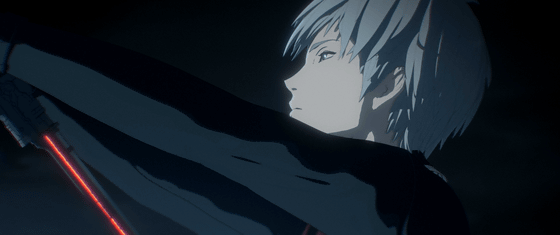
G:
To that idea (laughs)
Tow Ubukata:
In short, I should draw the process as a story of 'Dark Hero Bomb'. Not a well think twice and Dazai me it
G:
Did Mr. Kizaki make an offer after the decision was made? Were you involved in that process?
Director Fuminori Kizaki (hereinafter referred to as Kizaki):
The timing of receiving the proposal was the same. Is the first meeting, 'What should I do to complete this project,' about five years ago?
Tow Ubukata:
It was quite a while ago.
Kizaki:
I had a few face-to-face meetings with my supervisor, Katsuyuki Motohiro, over the next six months. Looking back on it now, I feel like 'I miss the meeting with Mr. Motohiro.'
G:
That was five years ago, so was the work quite difficult to deliver?
Kizaki:
It's a dystocia. It was hard.
G:
Is it a feeling that the project is ambiguous and undecided? Or is it that the opinions of each other collide and do not proceed?
Tow Ubukata:
Far from being a dystocia, he said, 'I have to fertilize for the time being' (laughs) 'Human disqualification' and science fiction must be combined to create a new life.
Kizaki:
That's right. Even if you say 'human disqualification', it is an original story, so even if you have a draft, it is a high hurdle to make it from scratch. So, whether it's a script or a design, various ideas and opinions come up, so the work of deciding them and coming up with new ideas was still heavy.
G:
It's a story draft, so I was wondering if Mr. Okata had already come up with ideas.
Tow Ubukata:
No, there were a lot of things to decide. That was the reason why the clothes should be like the Taisho era if it was 'human disqualification'. At first, there were designs like Bunkara and 'Haikara-san passes' (laughs).
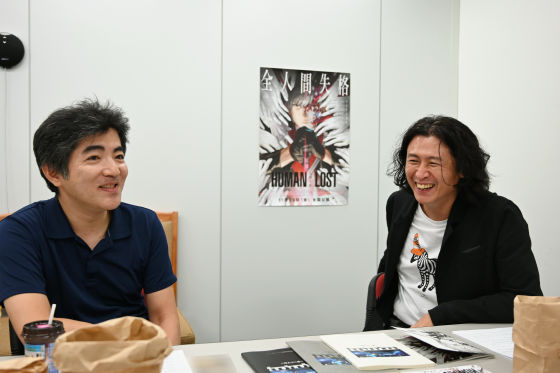
G:
I can't think of it from the final visual (laughs) When was it decided like this?
Tow Ubukata:
It's pretty late, isn't it?
Kizaki:
I agree
Tow Ubukata:
There are places where you've tried everything and come to a conclusion.
◆ Difficulty in script work
Kizaki:
I came up with ideas, made a plot based on Mr. Okata, and then came up with something like the first draft of the scenario, but during that time, the idea that 'I think this is better' comes out. So I rubbed it.
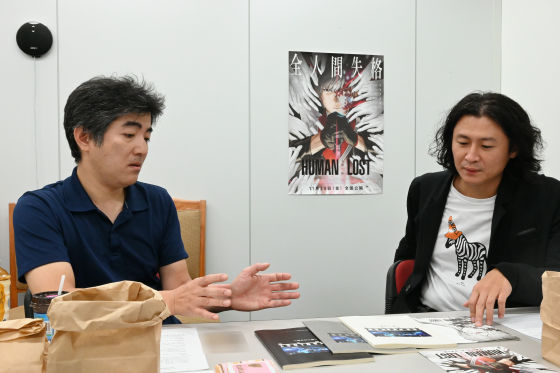
Tow Ubukata:
The interpretation of 'human disqualification' is different for each. 'I didn't really want to be like this, I wanted to be like this,' 'I think Shibata is such a person,' and 'Miko should be more mysterious.' So, 'Then, what do you want to do !?', I was a little sharp (laughs)

G:
Because everyone says what they like (laughs)
Tow Ubukata:
'Decide which one!'
G:
How did you decide from there?
Tow Ubukata:
I shake it to the director once, and then I receive it again. I knead the mochi and knead it. I did it many times.
Kizaki:
There was a time when I couldn't figure out which was the best of all the ideas. According to Mr. Okata, at that time, the director was in a state of not speaking at all.
G:
Has it been cornered and shut up?
Kizaki:
I didn't know what to put together and how, and I wanted to take it home and digest various things in myself. It was the first time for me to do such a stupid SF, and to be honest, when I saw Mr. Okata's first draft, it was too difficult to understand.
Tow Ubukata:
Hahahaha (laughs)
G:
You didn't mean to write it difficult, right?
Tow Ubukata:
………… But I thought it was a rather complicated story. At that time, I had all the ideas in it. 'Then, I'll put everything in, so let's see what happens.'
G:
I read it and said, 'I don't know.'
Kizaki:
Yes, 'I don't know.'
Tow Ubukata:
There was a feeling of being overloaded until the third draft. It's like 'I say this, but ...'.
G:
You said that you want to put that in, and you want to put this in too.
Tow Ubukata:
'Shut up a little' (laughs)
Kizaki:
There was such an air.
G:
'You can't go in so much!'
Kizaki:
I can't enter! (Lol)
G:
It's already a dystocia ... At the end of that, I think that the work of narrowing down the elements started somewhere from the point that 'I can not enter anymore'. What was the standard you left behind?
Tow Ubukata:
It's the final point with the main character. Will the relationship with the heroine and the relationship with the enemy be finally settled? In some cases, it was pulled without drawing a conclusion. So the first thing I decided was to 'make a conclusion, finish it properly'. Both talks with heroines and talks with enemies are 'fulfilled.' I tried to stop doing things like 'I'm sure I'll be able to see him again' that disappears beyond the flames.
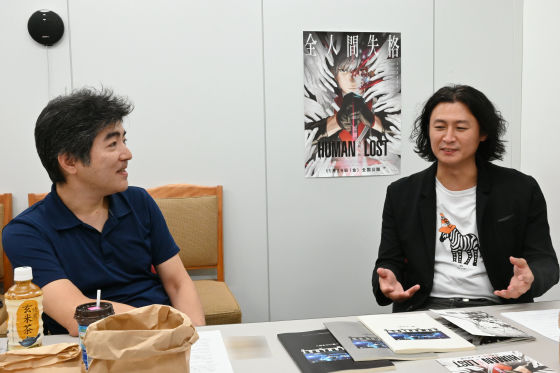
G:
(Lol)
Tow Ubukata:
I don't know where to go, so I'll stop.
Kizaki:
That was the case.
Tow Ubukata:
Once the main character decided which path to take, the next step was to clarify the motivation of each character as to what to do with the highest priority. I had no choice but to lower the priority of the feeling that 'If you want to remake Dazai, you want to include that and this too.'
G:
Did you get pretty sick?
Tow Ubukata:
At the beginning, the request 'I want to put in these lines if I do it' was cut down as 'I don't need it, I don't need this either'.
G:
It's like editing work.
Tow Ubukata:
While thinking 'Why am I choosing the requests, isn't the position reversed?' (Laughs), 'I don't need this scene because it's wasteful', and that kind of work is strictly done at the time of reading. After that, it was further brushed up when the director did the work to wake up the contest.
G:
When I listen to the story, I get the impression that Mr. Okata's burden was quite heavy ...
Tow Ubukata:
The pruning work itself was done at key points, so to be honest, it was the startup that had the hardest time. I have an order from the producers, but the specificity was almost 0.
G:
When you say almost 0, did you feel like starting from one pella?
Tow Ubukata:
I think it's about one or two. How to realize the cool phrase of the proposal.
Kizaki:
You had a dream.
G:
That was the type of project. I was wondering if it started from the point where I wanted to do something more tightly.
Tow Ubukata:
Born out of great chaos, I even felt like I was assembling a car while running (laughs).
Kizaki:
Just before disassembling, I felt like 'quickly! Fast!' (Laughs)
G:
So was there a myriad of screenplay fixes?
Tow Ubukata:
There are various elements, and if you do not decide the standard when you fix it, variations will be derived, so it feels like you decided that. For example, there are various possible versions, such as a version in which the heroine is alive, a version in which the heroine dies, a version in which reason remains when the leaf is transformed, and a version in which reason flies.
G:
I wonder if I have to do all the permutation combinations.
Tow Ubukata:
Ultimately, the most important thing was the relationship with Meiko. I'm impressed with what Meiko showed me, but after that, the conversation disappears, so there are plots that assume a little more romance or a scene that deepens the bond between Hazo and Meiko. did. What was that change?
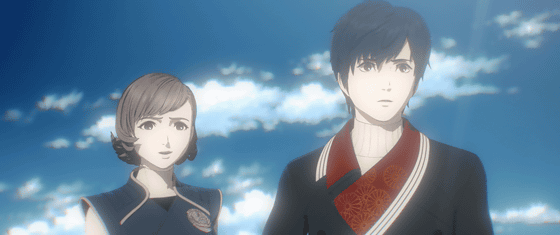
Kizaki:
I think that there was an adjustment that made the character's emotional aspect a little more important than the direction of science fiction, which was rather apt.
Tow Ubukata:
Meiko's character has become a bullish character, hasn't it? Initially, it was a quote from the original, and it was a more obedient and self-sacrificing heroine, but it's not interesting to see that it doesn't have a strong will. Horiki also became a transcendental mad scientist who was a little more human character.
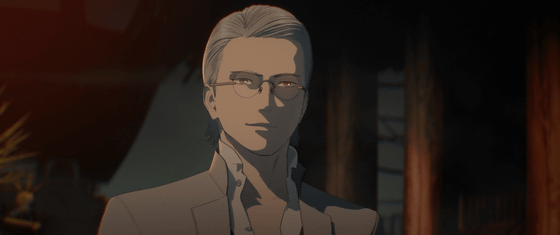
G:
Mr. Okata commented at the time of the production announcement that '
Tow Ubukata:
In fact, when various ideas come up, some people think 'Oh?'. For example, in a world without death, religion is no longer needed. That's why the temple has been abandoned and has become a hangout for runaway tribes, and no graves can be built. And the runaway tribe gathered at the crematorium will run away with a hearse while burning fire (laugh)
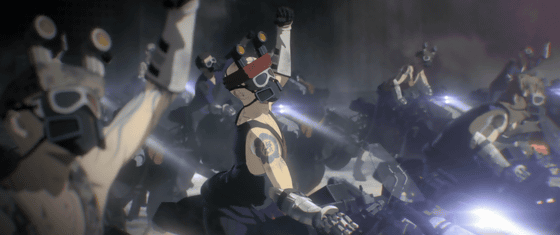
G:
That's how I came up with that idea. I think it will bring out amazing things.
Tow Ubukata:
Thinking about 'no illness,' 'no death,' and 'what will happen?', I think that workers will be forced to work because there are no industrial accidents. Japanese people are serious, so they work about 19 hours a day. I don't think so, and so on.
Kizaki:
It's a story that it's already lost.
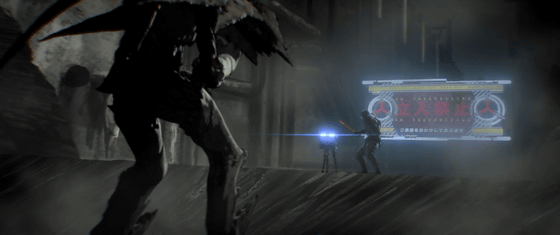
G:
(Lol)
Tow Ubukata:
There were various ideas for station advertisements. 'Pension revival'. 'Oh, my pension was gone once.'
(Everyone laughs)
◆ Visual construction centered on Kenichiro Tomiyasu
G:
In the process of making a video, you went in this direction from among a number of visual candidates. What kind of selection did you make in this direction?
Kizaki:
Kenichiro Tomiyasu, an artist who is in charge of concept art, came in from an early stage and asked me to come up with an idea, 'How about this?' So, I think that Mr. Tomiyasu's sense is quite strong in the basic direction. The runaway bikes don't have front wheels, they have a crazy design with a jet engine, and the drone has three legs.
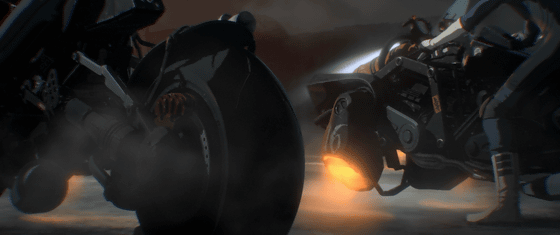
Tow Ubukata:
Mr. Tomiyasu was very particular about 'something is missing'. When I thought about what the runaway tribe would do if they didn't die and would soon be resurrected, they would cut off their limbs, stick them together, and do something like Wai.
Kizaki:
The runaway tribe has a mechanical right arm, and the engine does not start unless it is connected.

Tow Ubukata:
At the script stage, it starts with everyone cutting off the limbs that grow up soon ... (laughs) I thought that the cut off limbs were stuck in a bucket, but it was screened as expected. It's going to be banned.
Kizaki:
I think it's better to refrain from doing so. Also, with CG, a different model is required for site defects, and it seems that the hurdles are rather high.
Tow Ubukata:
You also had the idea of sticking too many things to the hearse. Stick exhaust pipes together.
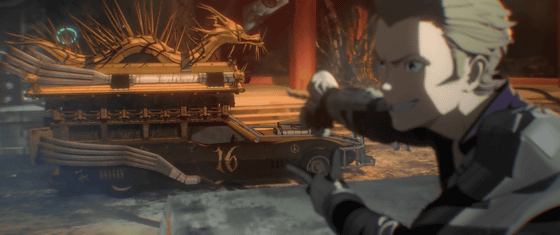
G:
There were a lot of insane ideas (laughs) What was the difficult part of this design?
Kizaki:
I think the design of 'SHELL', an organization that manages the health of the people, was the most difficult. It's an important symbol of the world view, so I came up with a lot of ideas, and Mr. Tomiyasu finally put it together.
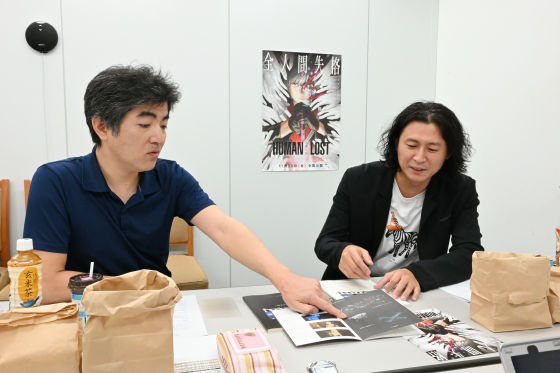
Tow Ubukata:
It's an image of a sterilization room with a cover.
G:
I am very convinced.
Tow Ubukata:
It is slightly inflated or dented.

Kizaki:
It is said that the air is sent out with a bellows.
Tow Ubukata:
Only ourselves are sterilized cleanly, and all the exhaust gas and germs generated from it are scattered outside (laugh)
G:
(Lol)
Kizaki:
I set it up from the image drawn by Mr. Tomiyasu, but the work was also very difficult. I make a set with a 3D model, but it is quite difficult to set such fine details as to how the steel frame is assembled, so I asked the Polygon Pictures artist to do that. I wonder if this was the hardest ...
Tow Ubukata:
But there are some results. It is said that the Japanese have drawn such a wonderfully wrong Japan (laughs) There are torii gates in the room, and there is a five-storied pagoda for no reason.
Kizaki:
There was talk of taking it overseas because I wanted to make it feel a little crazy (laughs), so I felt Japanese crazy that made me think, 'Isn't the Japanese thinking crazy?' I've been talking about trying to get it out since the time of the meeting.
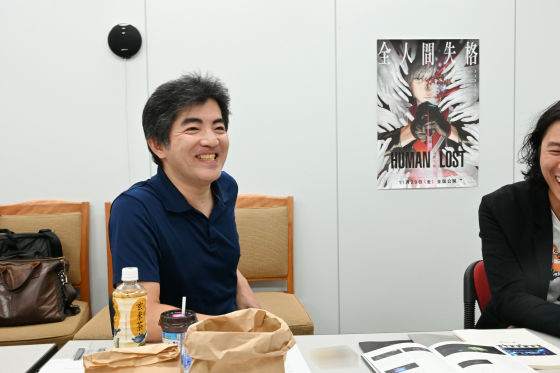
G:
This time, the visuals give the impression that everything is blown away. To reach this point, do we have to stack up one by one?
Kizaki:
No, it was just piled up.
Tow Ubukata:
It was the Sanzu River.
G:
Sanzu River!
Tow Ubukata:
'Ah ...' (laughs)
G:
Did you have a lot of work compared to other works?
Kizaki:
In that sense, it was a very difficult work. It's quite difficult just to say that it's an original, but I think that Polygon Pictures' artists have a lot of power, including the details of the contents.
G:
When you ask Polygon Pictures to make it, do you order from the director 'I want something like this'?
Kizaki:
If there was the original concept art, I asked them to give it to me, and if there was a design, I asked them to model it based on it. I made the missing parts here. I made a set with 3D modeling software called '
G:
Yeah !? Making it with SktchUp was a story of a person who is completely crunchy (laugh)
Kizaki:
No, it's just a simple model. I'm originally a completely hand-painted person. This time, I was allowed to do it with Mr. Polygon, so I thought that if I did CG, I would have to touch the model, and when I asked various people, I said that 'SketchUp' was good, and I was able to do it unexpectedly. It's getting more and more fun, and when I usually work for about 3 hours, I get tired ... but I've been touching it for about 8 hours.
G:
I'm really into it! (Lol)
Kizaki:
It's been fun (laughs)

Kizaki:
If you bring what you made, you will be asked 'What !? Did you make this!', So 'How about!' (Laughs) This time, I made a set model of the scene and made a storyboard, and also I had a meeting with. Since Polygon Pictures is a CG company, it was said that it was helpful to proceed in this way.
◆ Intense battle action by Eiji Ogushi's contest
G:
The teaser trailer that was originally released had a quiet and heavy atmosphere, so I didn't think it was such an action-filled work. What kind of storyboard should I cut to create this fierce battle?
Kizaki:
This time, the storyboard was
G:
Well, is that so?
Kizaki:
There are many restrictions on CG. That's why I ended up saying 'I can't do anything with this!' (Laughs), so I thought it would be best to have Mr. Ogushi do it. Come on ... Actually, the main story is a less action scene than the content.
G:
I'm shaving with that ... it's equivalent (laughs)
Kizaki:
I looked at the storyboard and said, 'Wow! You can do anything!' (Laughs) I thought that it would be possible because Mr. Ogushi, a former polygon, was doing this much, but I cut it because it was impossible. I am. Still, I didn't expect it to be such an actionable work.
Tow Ubukata:
In terms of restrictions, there were a lot of restrictions from the time of reading the book. Don't put out more than 10 people. Therefore, I thought that Kizaki-ism must have exploded to have become such a work. However, in fact, various people were exploding (laughs).
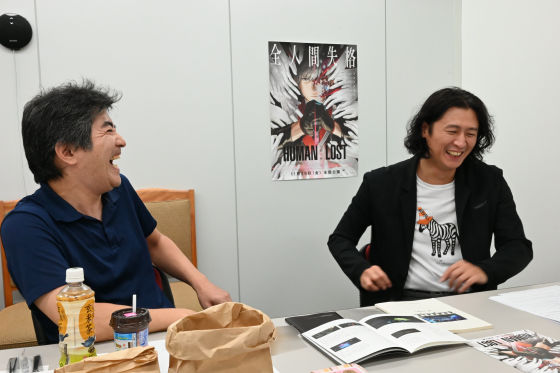
Kizaki:
(Laughs) Of course, we had a meeting when ordering, but Mr. Ogushi did the setup, the image, and things beyond that imagination. The good action was largely due to Mr. Ogushi's creativity.
G:
What was your impression when you saw that spectacular action contest? Is it like 'I see, did you come this way?' Or is it like 'I really wanted to do that!'
Kizaki:
It was strange, and when I got the storyboard, I was calm, saying, 'Oh, I'm not doing anything difficult.' However, there are some parts that can not be read only with storyboards, so when I was shown an animation using a model, I said 'It's amazing !!' (laughs) Mr. Ogushi likes long turns, and long cuts unique to CG I was making a lot of. I was shown it on the Toonboom Storyboard , but I didn't know where to go from one cut, and when I asked Mr. Otake, the animation director, later, I was surprised that 'This is one cut' and 'Yes !?' is. I think that Mr. Ogushi had cut the storyboard saying, 'If you use CG, you should be able to do this much.' I get a lot of things that I don't usually do.
G:
What kind of thing do you not do much?
Kizaki:
I think there were quite a lot of bird's-eye shots. That often doesn't work very well with drawing.
G:
Why doesn't it work?
Kizaki:
Especially in the case of drawing, it becomes more difficult as the amount of information increases. That is, Mr. Ogushi's camera work is closer to live action, and he has a lot of bird's-eye views, and the layout is such that the ground and buildings are always visible. From my point of view, I avoid it because of the burden of art, but Mr. Ogushi cannot escape. Relentless (laughs) I think the animators as well as the art staff were extremely difficult. There is a strong commitment from Mr. Ogushi.
G:
That was the reason why I thought, 'This kind of animation is rare.' I've avoided it so far, but what kind of things did you incorporate in this work?
Kizaki:
It is a high-calorie scene such as a crowd scene or a collapse scene. It depends on the strength at that time, but it is difficult. This time it's CG, so ... CG is difficult with CG, but I'm actively doing it.
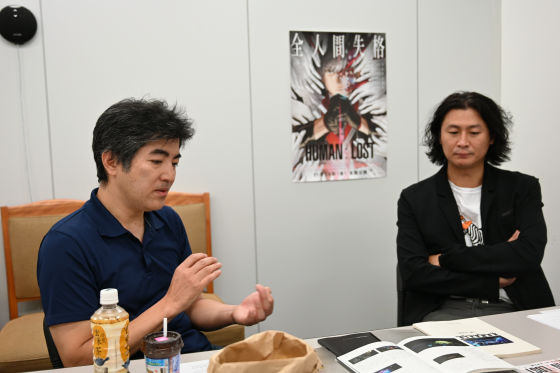
◆ Director Kizaki
G:
This work is a CG work, but as Mr. Kizaki himself said earlier, he was originally a hand-painted animator. Did you aim to be an animator since you were a kid?
Kizaki:
I wanted to be an animator when I was in high school.
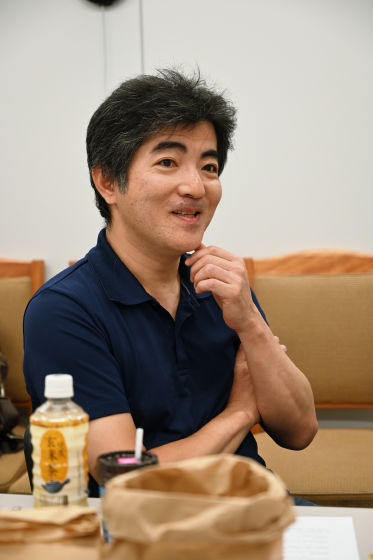
G:
Did you have any chance?
Kizaki:
There was an anime boom around 'Macross' ... 'Gundam', 'Macross', and 'Nausicaa', so I went to
G:
How did you become a director from there?
Kizaki:
Originally I wasn't aspiring to be a director, and I thought it would be great if I could eat as a painter in the industry. I happened to have the opportunity to draw a storyboard, and although I was interested in directing it, I wasn't even thinking about doing it as a director ... There were people who pulled it up, and there were friends who would fight with me, so then. It was 'Basilisk-Koga Ninpocho- ' that I decided to do.

G:
I see, it's pretty close to drawing.
Kizaki:
Since the director business has to be careful in all directions, it feels like 'it's more fun and comfortable to draw only pictures.'
G:
Mr. Kizaki is a member of 'Studio Heracles', but what about Heracles now? Ken Otsuka tweeted that the telephone was abolished in 2013.
Kizaki:
Actually, I don't really understand either. I haven't been in it for about 15 years. Some members haven't met for more than 13 years. Everyone is too busy and there is almost no communication, so I don't feel like I belong to Herasta anymore. Twice a year, the spatula douujinshi is published twice a year in summer and winter, and an email 'Did you make the manuscript?' All the members are in a responsible position, so I think that Mr. Watanabe, the representative, is sometimes included.
◆ 'HUMAN LOST Human Disqualification' as the latest CG movie of Polygon Pictures
G:
Is there any place where Mr. Kizaki, who has a career as a hand-painted animator, created this work, which is a full CG work, and his perception of CG has changed from before?
Kizaki:
I was originally a fan of the original ' Knights of Sidonia'. Since it will be an animation, I was thinking 'I'm looking forward to Polygon Pictures production .... What kind of thing can I do?' And waited, 'It's amazing, can I do it so far!' .. Moreover, in the TV series!

Kizaki:
From an early stage, I was wondering what kind of feeling I would like to work with Mr. Polygon. I was also interested in CG animation itself, so this time I realized that the technology is constantly evolving by actually doing it, and that I am doing it at the highest level at the time this work was made. felt. Therefore, it is more advanced than the Polygon Pictures works so far, and I think that the future works will be amazing based on 'HUMAN LOST human disqualification'.
G:
What was your impression of Okata-san when you saw the completed main story?
Tow Ubukata:
To put it bluntly, 'It's finally time to see CG animation.' The emotions and facial expressions are firmly on board, and some people who see it for the first time do not think that everything is CG, right?
Kizaki:
Certainly, it is sometimes said that it is a 'hybrid'.
Tow Ubukata:
I even thought, 'This is really hand-painted.' But it's all CG, isn't it? Obviously the overall level was up and I thought this was the explosion of Kizaki-ism.
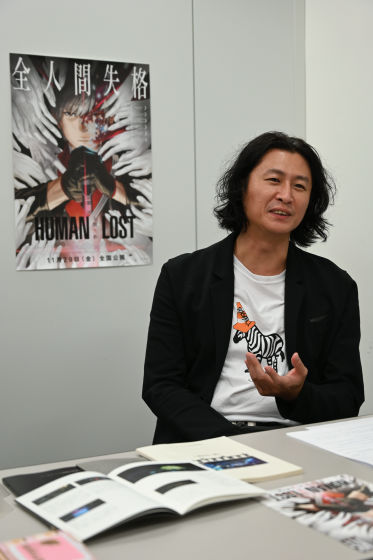
Kizaki:
This time, it was my first time to work on CG, so the part left to the polygon artist was rather large. Their ideas are abundant in getting them to work. I think he did it quite like it.
Tow Ubukata:
You can see the feeling of 'all you want to do' everywhere.
G:
How does Mr. Okata perceive the development and development of CG?
Tow Ubukata:
Up until now, I think there was a part of 'catch up with hand-drawn animation', but if it becomes clear what CG is good at and what it is not good at, I think it will become a competition including live-action. I will. The interesting thing about CG is that you can use the accumulated past data. In order to utilize it, a huge database is also needed. As an episode, I heard that Mr. Polygon made a CG of a fried egg, but he didn't know where he went and remade it.
Kizaki:
It
Tow Ubukata:
You need to think in the long run. Continuing to accumulate means that you can add what you have in the past, which should be a tremendous cost cut in the future. Initial capital investment is difficult, but ...
Kizaki:
The software license fee is not cheap either ...
G:
The cast members are very gorgeous in this work. Is there a request from the director?
Kizaki:
I left the casting to the producers. At first, there was talk that the actors would be good, but in the end I settled on this cast. Mamoru Miyano , who played the role of Hazo, had already read the script when he came and thought that he was an excellent actor on the front line.
G:
Did Mr. Okata match the image he wrote when he wrote it, or did it look like this?
Tow Ubukata:
There is nothing to say when it comes to this level of cast. The rest is not about the characters, but about whether the voice play and the picture play match. At the scene, I sometimes realize that it's hard to make an impression when I say this line in this scene, but in the case of this work, I didn't think about anything. 'This is the one who doesn't have to go to dubbing. There's nothing to say even if I go' (laughs)
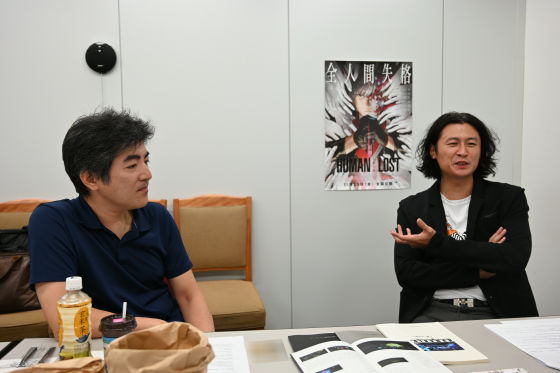
G:
(Laughs) I think there are many people who think that the catch phrase is 'all human beings, disqualified' and 'what kind of work is it?' Please let us know if there are any points that you would like us to see.
Tow Ubukata:
I want you to enjoy the Dark Hero Bomb while laughing. I've included a serious theme, but it's full of naked leaves.
(Everyone laughs)
Tow Ubukata:
It's like 'a life with a lot of shame' !? (laughs) Besides, I think you can enjoy runaway scenes and action scenes, and there are plenty of science fiction gimmicks and gadgets. What I really want to show is the crazy activity of dark heroes.
G:
How about Mr. Kizaki?
Kizaki:
People tend to think that it is a work with a rather heavy theme because it is 'human disqualification', but I think that it is an action entertainment work that everyone can enjoy while having the original plan of Professor Dazai. All the staff are particular about the production, so I would appreciate it if you could see it many times at the theater.
G:
Thank you for your time today.
The movie 'HUMAN LOST No Longer Human', which is based on Osamu Dazai's 'No Longer Human' and arranged as a bold science fiction, will be released today from November 29, 2019 (Friday).
The video of the first 7 minutes of the main story is also released, so please refer to it when you go to see it.

[All humans, disqualification] Released on November 29 Theatrical animation 'HUMAN LOST Human disqualification' Official Main Trailer Starring: Mamoru Miyano --YouTube
◆ 'HUMAN LOST human disqualification' work information
Original plan: From Osamu Dazai 'No Longer Human'
Supervisor: Katsuyuki Motohiro
Director: Fuminori Kizaki
Story draft / screenplay: Tow Ubukata
Character design: Yusuke Kozaki
Concept art: Kenichiro Tomiyasu (INEI)
Animation production: Polygon Pictures
Planning / Producing: MAGNET / Slow Curve
Distribution: Toho Imaging Division
© 2019 HUMAN LOST Project
Related Posts:






